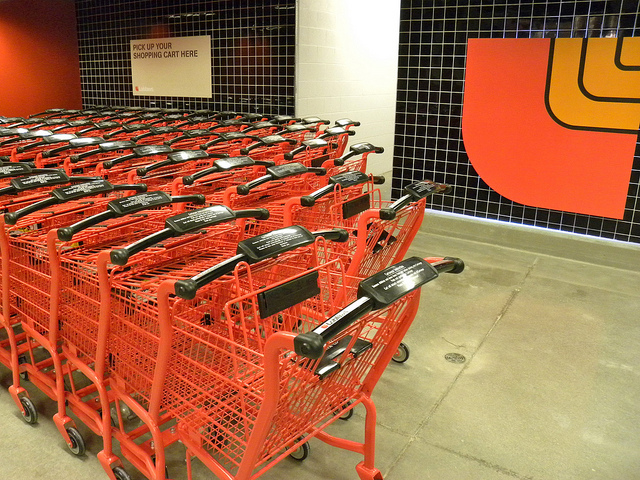As Target Canada tumbled into bankruptcy, Loblaw announced that its fourth-quarter profits more than doubled. What can be learned from this tale of two retailers?
The main reason for Loblaw’s surge was its acquisition of Shoppers Drug Mart last March, which turned it into Canada’s largest grocer and pharmacy chain. Shoppers contributed $3 billion to Loblaw’s $11.4 billion take in sales, a 50 per cent jump. Profits more than doubled from the previous year as Loblaw also saw cost savings from the merger. The irony behind this success story is that it was likely Target’s arrival on the retail landscape that forced Loblaw to step up their game.
Mergers and acquisitions have become a quick way to grow the bottom line for business. But larger scale isn’t the whole explanation in this case. Loblaw also saw strong growth in same-store sales compared to a year ago, a critical metric for retailers who need to show shareholders they’re building business, not coasting. Grocery sales boosted revenues, but a big part of that was higher prices, not higher volumes.
How will that extra cash get spent? There’s been speculation that Loblaw is eying some of Target’s 133 idled locations. But their CEO, Galen Weston, doesn’t sound too interested, saying it might choose a handful of locations that are “complimentary” to their current holdings.
Frankly Loblaw’s expansion plans aren’t like Target’s. It doesn’t need more stores. It already has 2,300 outlets across Canada. Rather, its growth path is following the same formula as Wal-Mart: a wider range of products packed into the aisles at existing locations.
Taking a page out of that playbook, Loblaw is rolling out fresh food items into 14 Shoppers stores. It plans to put Joe Fresh clothing in 50 new locations. And it’s heading deeper into pharmaceuticals and health-care services. The company just opened a call centre staffed by 50 pharmacists and 70 pharmacy assistants, and is negotiating with provincial governments about providing services beyond flu shots.
Loblaw’s sales won’t see the same whopping increase as this week’s announcements, but they’re on track for solid growth over the next year. Target’s going-out-of-business sales will eat into Loblaw’s business for a while, but then, like other survivors, Loblaw will take up some of that abandoned market share.
Profits will also get a boost from “synergies” arising from the Shoppers takeover, to the tune of about $200 million in 2015.
A devalued loonie will, ironically, push up sales too, though not necessarily profits, due to higher import prices. Much of the staples and fresh food we buy comes from the U.S. They’ll all cost more.
The more likely way Loblaw — and other big retail chains — will eke out extra profits is by squeezing their suppliers harder, just like their major competitor, Wal-Mart.
The bigger you are in business, the more power you have, the more you can demand. And Loblaw has been demanding some pretty tough deals with suppliers lately. So tough that the Competition Bureau started an investigation into their pricing practices in December.
I just heard about an Ontario mushroom farm that sells almost half of its production to Loblaw. Its workforce used to be 100 per cent Canadian. But Loblaw continued drive to lower prices has pushed the farm into employing a big contingent of temporary foreign workers, at much lower wages.
The secret sauce to Loblaw’s success comes with a bitter aftertaste.
The truth is, growth can’t come only from raising prices. Customers will eventually buy less, or turn to cheaper, lower-margin items. And the big chains can’t squeeze suppliers forever. Such tactics will eventually push the suppliers out of business. The grocery wars will rage for some time yet, especially in population dense areas. Expect aggressive price competition, ruthless bargaining and even more corporate concentration.
But there will be survivors, and they will set the prices. They’ll set then as high as they can, and pass on as little of the extra profit as possible to suppliers and workers.
Loblaw will undoubtedly be a survivor of the grocery wars, because it has bulked up to such a formidable size. It also owns No Frills, Real Canadian Superstore, T&T, Fortino’s, and Provigo; not to mention Joe Fresh, President’s Choice Financial Services, and its own real estate company.
Size matters. And the bigger the players, the more we need to be able to trigger regulatory scrutiny of pricing practices and supplier relations. Let’s hope the regulators are given enough resources to do their job well. Without such referees, we’d all be living a real-life game of Monopoly.
This blog is based on my February 27, 2015 piece for CBC Radio’s Metro Morning, where I have a business column on Wednesday and Friday mornings.
Photo: JasonParis/flickr




